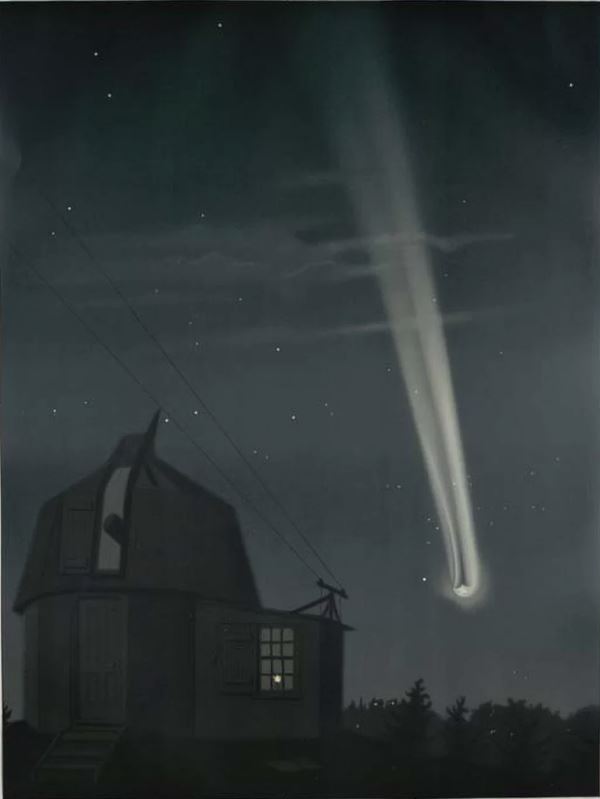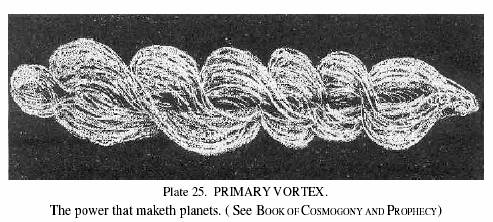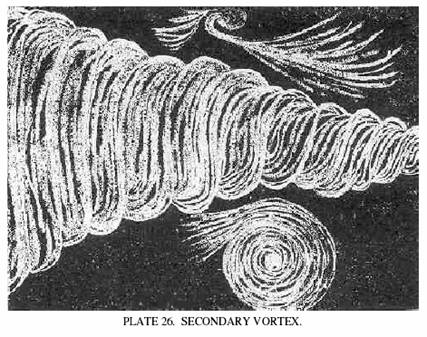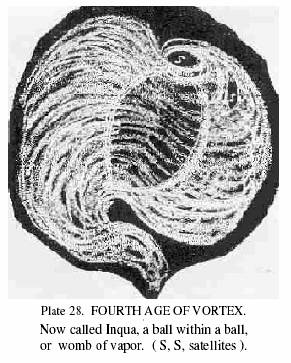Oahspe Study
Comets and their Vortices
|
|
|
A chromolithograph of the great comet of 1881 Credit: E.L. Trouvelot/NYPL |
The
invisible force that holds the physical universe together --- the
unified theory --- the manifestation of heat, light, magnetism, electricity,
apparent gravity is VORTEXIA, THE POWER OF THE VORTEX.
Before Einstein pondered curved space, before magnetospheres were mapped,
before the solar wind was registered, Oahspe described the Vortex, which
condenses dissolved matter out of apparent empty space, with the power to make
suns, stars, planets, moons, comets. The vortex --- the original force ---
heat, light, electricity, etc. are all various manifestations of vortexia.
It is only with today's technology that evidence of invisible vortices are being registered around planets and suns. Now the humble comet yeilds evidence of its own not so insignificant vortex!
Since scientists have been able to send instruments into space to encounter comets and receive data directly, they have been constantly surprised and mystified, as most of what they think they know about comets and other celestial bodies is being challenged and new unexpected questions continually arise.
No less challenging are the findings of the unintentional encounter of a comet's tail by Ulysses space craft, which had previously flown through a comet's tail and failed to register what this time was registered as no less than the effects of the magnetic field of the comet. This was indicated by the "solar wind" meeting a significant resistance and charge, as would be expected when the 'solar wind' encounters a magnetosphere of a planet. (See below for reference). "The region around a planet where the magnetic field is strong enough to slow down or even repel the solar wind is called the magnetosphere".
What was detected was the magnetosphere of the comet at least 160 million miles from its nucleus! This is an extraordinary revelation to scientists, since even the tail end of the magnetosphere of a decent sized planet such as Earth is nowhere near that length. And the idea that a comet has a magnetosphere challenges the very foundation of what scientists believe is the cause of a magnetosphere.
Less than 50 years ago, scientists believed that the tail of the comet was formed solely by the heating of icy particles as the comet travelled closer to the sun. But the direction of the comet tail whether it was travelling toward the sun or away from the sun indicated there was some force travelling from the sun outward, pushing the tail before it, because the tail streamed away from the sun even though the comet itself was moving away from the sun. This observation led to the discovery of the `solar wind'. But what they didn't know up until now, was that the 'solar wind' met resistance of the tail of a comet so far away from its visible tail - some 160 million miles from the nucleus of the comet! This means that a magnetic field extended an enormous distance from the centre of a small chunk of material only a few kilometres in diameter!
And here again is Oahspe validated in its extensive unparalled information about vortices, only a fraction of which is quoted here. A comet is no less than a potential planet in an "embryonic" stage, accreting substance as it ranges within a larger vortex, such as the one in which the sun and its planets abide.
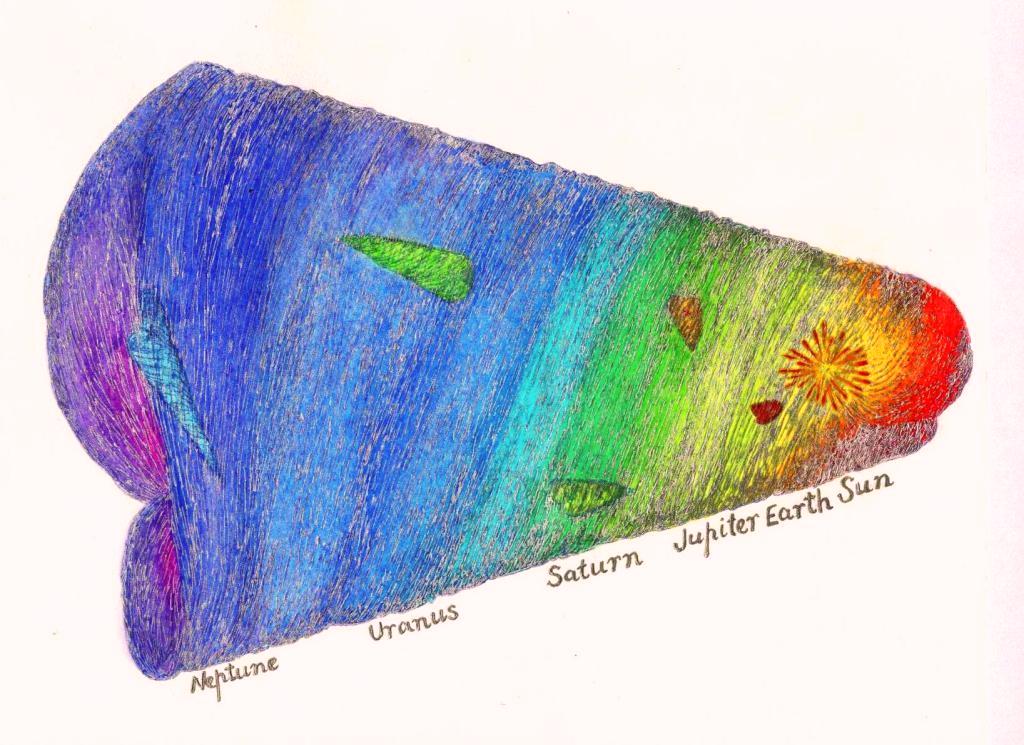
A comet is the subject of the vortex in its earliest stage when it is long and extended as in the primary vortex shown in the image below. The shape of the primary vortex is long and extended, needle-like, but as the vortex matures its shape changes, as shown in the second image below, first spiraling upon itself, winding up its tail to become conical and then in its third stage it tends toward the globular shape. Oahspe's descriptions follow:
|
Book of Cosmogony and Prophecy,
38/2.8.
|
|
|
Book of Lika, 26/7.4.
|
|
The description from Oahspe of the comet "Yo-to-gactra" describes a more advanced stage of planetary development than many of the early stage comets frequently observed in the solar system from earth. "the nucleus of Hale-Bopp may be more than 30-40 kilometers in diameter. The nucleus of Comet Hyakutake, by comparison, is less than three kilometers in diameter; Comet Halley's nucleus measures about 15 by 8 kilometers." (Planetary Science Institute).
The ratio of Yo-to-gactra's nucleus and tail (the nucleus being four thousand miles diameter and the tail 30 million miles long), and its tail reducing in size as it progesses in the secondary stage of a vortex, indicates its vortex would appear like that of the smaller top image in plate 26. (The two lower images being even more advanced, the cone being a side on view and the "spiral pinwheel" being a cross sectional view.)
For comparison below are some figures for the length of magnetosphere of the earth and Jupiter:
Nasa, History
|| The measurements from many space missions have been combined to reveal
that the Earth's magnetosphere is blown out by the solar wind into
a teardrop shape. The head of the drop extends only about
10 Earth radii, or about 65,000 kilometers (40,000 miles) "upwind"
toward the Sun. The tail of the drop stretches away in the direction opposite
the Sun,
actually reaching beyond the Moon's orbit. This long magnetotail extends more
than 600,000 kilometers (370,000 miles) from the Earth. ||
Nasa, Galileo
|| The Galileo tour will include a large looping orbit that provides two
months in the near-planetary regions of the tail where evidence of
similar processes will be sought. (Jupiter's tail may extend as far as
Saturn, over 650 million kilometers (390 miles) distant, but Galileo will go
only
about 11 million kilometers (7 million miles) down the tail.) ||
|
The actual length of the tail of Jupiter's Magnetosphere is not known, and the estimates given for earth's vary greatly, therefore they are difficult to compare, but the difference between earth's tail and that of a comet, is measurable. The length of the magnetosphere of the comet tail being more than 160 million miles compared to earth's being estimated from 370 thousand miles to 6 miles in length indicates the great difference in the shape of their magnetic fields which to some extent indicate the shape of the vortex. The earth's vortex being in the mature globular stage (beyond the Fourth Stage, as shown in Oahspe, Plate 28 [1882 Ed.]) has a relatively short m'vortexya (North and South Dipole).
|
|
University of
Michigan, News release
|| 1 Oct 2007.....So a chance encounter between spacecraft Ulysses and Comet
McNaught's ion tail has scientists in the University of Michigan's College of
Engineering marveling at a stroke of luck and some surprising
data.......Not only did SWICS detect unexpected ions in the comet tail, it
found that the tail had a major impact on the surrounding solar wind.
For the first time at a comet, researchers detected O3+ oxygen ions (atoms of oxygen with a positive charge because they have five electrons instead of eight). This suggests that the solar wind ions, originally missing most of their electrons, picked up some of their missing electrons when they passed through McNaught's atmosphere. The comet served as a source of electrons, said Michael Combi, a U-M space science professor who is an author of the paper.
SWICS also found that even at 160 million miles from the comet's nucleus, the tail had slowed the solar wind to half its normal speed. The solar wind would usually be about 435 miles per second at that distance from the sun, but inside the comet's ion tail, it was less than 249 miles per second.
"This was very surprising to me," Combi said. "Way past the orbit of Mars, the solar wind felt the disturbance of this little comet. It will be a serious challenge for us theoreticians and computer modelers to figure out the physics."......what happened when we caught the tail of a comet that happened to pass very near the sun. ||
All Oahspe references are from the Standard Edition Oahspe of
2007
● GO TO NEXT ARTICLE: Configuration of the Vortex
